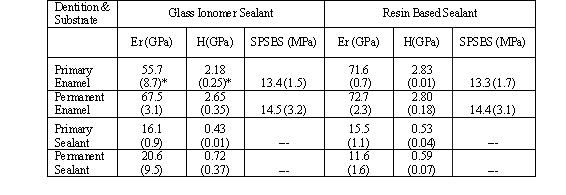ABSTRACT: 1052
Interfacial structure, bond strength and nanomechanical properties of two sealants
| L.M. PINZON1, F. RAMOS-GOMEZ2, L.G. WATANABE1, S.A. GANSKY1, J.A. WEINTRAUB1, A. TOMSIA3, S.J. MARSHALL1, and G.W. MARSHALL1, 1University of California San Francisco, USA, 2University of California Los Angeles, USA, 3Lawrence Berkeley National Laboratory, CA, USA |
Objective: To determine bond strength (BS), nanomechanical properties [hardness (H) and elastic modulus (Er)] and interfacial morphology of two enamel bonded sealants. Methods: The enamel occlusal surfaces of 6 primary and 6 permanent human teeth were cleaned with cotton rolls prior to application (following manufacturers' instructions) of one of 2 sealants: Triage glass ionomer sealant (GI, GC-America) and Clipro resin-based sealant (RB, 3M-ESPE) and stored in HBSS at 37░ C for 24h. Bonded interface cross-sections (n=3/group) were polished to 0.025 Ám. Lines of ~14 nanoindentations were made at 2Ám intervals across the enamel/sealant interface. Single Plane Shear Bond Strength (SPSBS) to enamel was measured using 10 primary and 16 permanent human teeth polished through 320-grit SiC. Specimens were debonded at a cross-head speed of 5 mm/min. Failure modes were determined at 100X. SEM was used to study the hybrid layer microstructure after 5N HCl/5%NaOCl treatment or fracture of the interface. H, Er and SPSBS means (SDs) were analyzed using mixed effects ANOVA with Tukey-Kramer post-hoc tests by substrate (H&E) or ANOVA (SPSBS). Results: (Table given below) RB hybrid layers were ~5.0 ým thick. GI revealed no hybrid layer. Conclusions: Nanomechanical properties differed significantly between sealants in primary enamel (*TKp<0.05). Bond strength did not significantly differ between dentitions or sealants. SEM showed morphologic differences among sealants. Supported by US/DHHS/NIH/NIDCR P01DE09859, T32DE07306, U54DE14251; GC America and 3M-ESPE supplied materials.
|
| Seq #154 - Adhesive Materials 10:45 AM-12:00 PM, Saturday, April 5, 2008 Hilton Anatole Hotel Trinity I - Exhibit Hall |
|
Back to the Dental Materials 2: Adhesion - Leakage/Margin Assessments Program |
©Copyright 2008 American Association for Dental Research. All Rights Reserved.
